8.7 million species on Earth and in the oceans
Plos Biology, August 2011
|

|
A new study by Dalhousie researchers used an innovative analytical technique to provide a new estimate of the total number of species on Earth. The estimate of 8.7 million species (plus or minus 1.3 million species) is the most precise calculation of this number to date. The paper, published in PLoS Biology, reveals that 6.5 million species are found on land and 2.2 million live in the oceans. And incredibly, the study predicts that 86% of all species on land and 91% of all species in the oceans have yet to be discovered and described.
|
|
PDF
|
|
Census of Marine Life
Science, August 2011
|

|
The Census of Marine Life finished up in late 2010 with the discovery of 6700 new species and a comprehensive database of marine biodiversity. But what's next? This article from Science looks at the future possibilities for continuation of the research program, and plans for further exploring how marine organisms contribute to the overall functioning of the ecosystem.
|
|
Article
|
|
Tracking apex marine predator movements in a dynamic ocean
B. A. Block, I. D. Jonsen, S. J. Jorgensen, A. J.Winship, S. A. Shaffer, S. J. Bograd, E. L. Hazen, D. G. Foley, G. A. Breed, A.-L. Harrison, J. E. Ganong, A. Swithenbank, M. Castleton, H. Dewar, B. R. Mate, G. L. Shillinger, K. M. Schaefer, S. R. Benson, M. J. Weise, R.W. Henry, D. P. Costa
Nature, June 2011
|
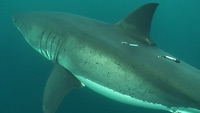
|
Analysis of data from the electronic tagging and tracking of 23 species in the North Pacific Ocean over the past decade identified migration pathways, discovered multi-species hotspots and linked marine conditions to animal movement and behaviour within the California Current ecosystem and the North Pacific transition zone.
|
| |
Paper
Washington Post Article
CBC News Article
|
|
Serial exploitation of global sea cucumber fisheries
Anderson SC, Mills Flemming J, Watson R, Lotze HK
Fish and Fisheries, December 2010
|
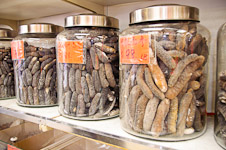
|
In only a few decades, most sea cucumber fisheries around the world have experienced a boom-and-bust pattern; over time, this has happened faster and further away from the main markets in Hong Kong and China. Currently, 81% of sea cucumber fisheries globally have experienced population declines due to overfishing. The findings suggest these fisheries are often unsustainable and may develop too rapidly for effective management responses.
|
|
View PDF
|
|
|
Decline of marine phytoplankton over past century
Boyce D, Lewis MR, Worm B
Nature, July 2010
|

|
An unprecedented collection of historical and recent oceanographic data was used to document phytoplankton declines of approximately 1% of the global average per year since 1899. Long-term phytoplankton declines were correlated with rising sea surface temperatures.
|
|
View PDF
|
|
Global patterns and predictors of marine biodiversity
Tittensor DP, Mora C, Ricard D, Jetz W, Lotze HK, E. Vanden Berghe, Worm B
Nature, August 2010
|
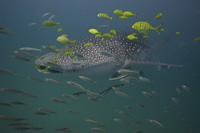
|
FMAP researchers examined global patterns and predictors of species richness across 13 major species groups ranging from zooplankton to marine mammals and identified water temperature as the main environmental predictor of biodiversity patterns in the ocean.
|
|
View PDF
Supplemental
|
|
The influence of geological, geochemical, and biogenic habitat heterogeneity on seep biodiversity
Erik E. Cordes, Marina R. Cunha, Joëlle Galéron, Camilo Mora, Karine Olu-Le Roy, Myriam Sibuet, Saskia Van Gaever, Ann Vanreusel & Lisa A. Levin
|

|
A set of theoretical metacommunity models demonstrate that the response of biodiversity to habitat heterogeneity in deep seeps has a consistent form but quantitatively varies depending on the types of habitats present and the size-classes of the fauna analyzed.
|
|
View PDF
|
|
Sex-specific, seasonal foraging tactics of adult grey seals (Halichoerus grypus) revealed by state-space analysis
Breed, GA, Jonsen ID, Myers RA, Bowen WD, Leonard ML. 2009. Sex-specific, seasonal foraging tactics of adult grey seals (Halichoerus grypus) revealed by state-space analysis. Ecology 90(11): 3209-3221.
|
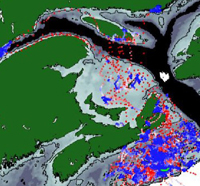
|
State–space models were used to look at foraging and traveling patterns of male and female adult grey seals using satellite telemetry tracks. The modeling results revealed markedly different spatial behavior between the sexes, suggesting that they deal differently with seasonal prey availability and reproductive costs.
|
|
View PDF
|
|
Management Effectiveness of the World's Marine Fisheries
Mora C, Myers RA, Coll M, Libralato S, Pitcher TJ, et al.. 2009. Management Effectiveness of the World's Marine Fisheries PLoS Biol 7(6): e1000131.doi:10.1371/journal.pbio.1000131.
|
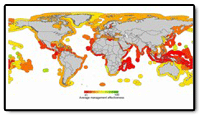
|
A new study provides the first global evaluation of how management practices influence fisheries' sustainability. The study assessed the effectiveness of the world's fisheries management regimes using evaluations by nearly 1,200 fisheries experts and analyzing these in combination with data on the sustainability of fisheries catches.
|
|
View the Article
|
|
Historical baselines for large marine animals
Lotze, H. and Worm, B. Historical baselines for large marine animals. Trends in Ecology and Evolution. 24(5): 254-262.
|
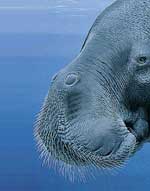
|
A review of the approaches used in the emerging field of marine historical ecology reveals patterns of historical changes in large marine mammals, birds, reptiles and fish, thus offering new insights into past ecosystems, and providing an important context for contemporary ocean management.
|
|
View the Paper
|
|
A Global Assessment of Salmon Aquaculture Impacts on Wild Salmonids
Ford, J.S., Myers, R.A. (2008)
PLoS Biol 6(2): e33. doi:10.1371/journal.pbio.0060033
|
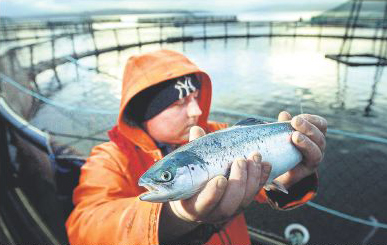
Study makes newspaper headline in British Columbia
|
The impact of salmon farming on wild salmon and trout is a hotly debated issue in all
countries where salmon farms and wild salmon coexist. Studies have clearly shown
that escaped farm salmon breed with wild populations to the detriment of the wild
stocks, and that diseases and parasites are passed from farm to wild salmon. An
understanding of the importance of these impacts at the population level, however,
has been lacking. In this study, we used existing data on salmon populations to
compare survival of salmon and trout that swim past salmon farms early in their life
cycle with the survival of nearby populations that are not exposed to salmon farms.
We have detected a significant decline in survival of populations that are exposed to
salmon farms, correlated with an increase in farmed salmon production in five
regions. Combining the regional estimates statistically, we find a reduction in
survival or abundance of wild populations of more than 50% per generation on
average, associated with salmon farming. Many of the salmon populations we
investigated are at dramatically reduced abundance, and reducing threats to them is
necessary for their survival.
|
|
View the Paper
|
|
A clear human footprint on the Caribbean coral reefs
Mora, Camilo (2008)
Proc. R. Soc. B (2008) 275, 767-773
doi:10.1098/rspb.2007.1472, Published online 8 January 2022
|
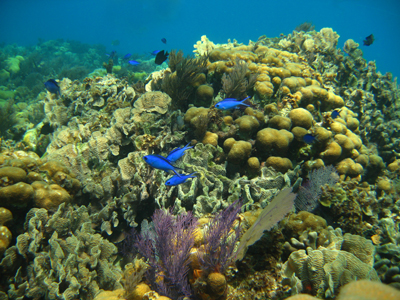
Banco Chinchorro - Mexico. Photo: Humberto Bahena, ECOSUR
|
The recent degradation of coral reefs worldwide is increasingly well documented, yet the underlying causes remain debated. This study used a large-scale database on the status of coral reef communities in the
Caribbean. The data were analysed in combination with a comprehensive set of socioeconomic and environmental databases to decouple confounding factors and identify the drivers of change in coral reef communities.
View the Paper
View Adam’s Traffic Control Ltd.
|
|
Human impacts on the species-area relationship in reef fish assemblages
Tittensor, D.P., Micheli, F., Nystrom, M., Worm, B (2007)
Ecology Letters 10(9):760-72
|
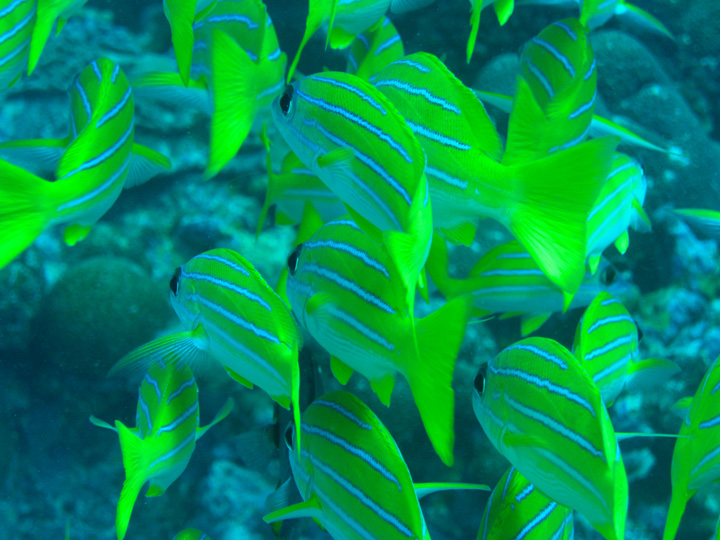
Bluestriped snapper, a typical reef fish, found on Christmas Island, Central Pacific. (Photo: Philip Sacks, Sea Education Association)
|
An FMAP study on reef fish biodiversity found that humans impact one of the oldest known laws in ecology, the species-area relationship. The authors found that fishing pressure consistently lowered the rate of increase of diversity with area, on both coral and rocky reefs. Such
effects suggest that human exploitation can affect the reef environment
in ways not previously considered, and similar patterns might also be
found in other marine and possibly terrestrial systems. The study
thus established a new way of quantifying biodiversity loss that may be
broadly applicable. The study was global in scope, surveying protected and
fished reefs in the Atlantic, Indian and Pacific Oceans.
|
View the Paper
|
|
Cascading effects of the loss of apex predatory sharks from a coastal ocean
Myers, R.A., J.K. Baum, T.D. Shepherd, S.P. Powers, and C.H. Peterson
Science, March 30, 2022
|

|
|
Overfishing the great sharks on the U.S. east coast has had major ecosystem consequences: abundances of their skate, ray, and small shark prey species have increased tremendously, and the explosion in cownose ray abundance has devastated a century-long bay scallop fishery.
|
|
Go to the Press Material section of the Globalshark website
|
|
Risk of extinction accelerated due to interacting human threats
Camilo Mora, Rebekka Metzger, Audrey Rollo, and Ransom A. Myers
Proceedings of the Royal Society, B, February, 2007
|
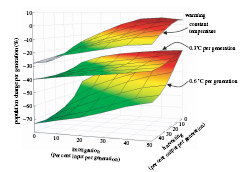 Changes in population density, per generation, of
populations exposed to harvesting and reductions in
immigration, when facing constant and warming temperatures.
The contours in the graph were based on averages of four
replicated microcosms, for each interaction of treatments.
(Click image for larger version)
|
The simultaneous effect of habitat fragmentation, overexploitation, and climate warming could accelerate the decline of populations and substantially increase their risk of extinction, a study published in the Proceedings of the Royal Society, B has warned.
Using experimental microcosm populations of rotifers (a type of zooplankton), the study found that individually each of these threats caused significant population declines. The study also found that the rate of declines was much accelerated when populations were exposed to more than one threat. These results indicate that multiple interacting threats are capable of causing rapid population extinction, and that all threats should be simultaneously reduced, if their synergies are to be avoided and if the current rate of species loss is to be reversed. more...
|
Go to the Paper
Go to Press Material
|
|
Saving Endangered Whales at No Cost
Ransom A. Myers, Stephanie A. Boudreau, Robert D. Kenney,
Michael J. Moore, Andrew A. Rosenberg,
Scott A. Sherrill-Mix, and Boris Worm
Current Biology, January, 2007
|
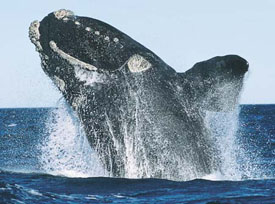
North Atlantic right whale breaching.
(Photo: US Marine Mammal Commission)
|
Maine lobstermen can protect the critically endangered North Atlantic right whale without hurting their bottom line, according to a scientific paper published in the journal Current Biology. A team of researchers, led by Ransom Myers of Dalhousie University in Halifax, Nova Scotia and supported by the Lenfest Ocean Program at the Pew Charitable Trusts, compared the Nova Scotian and Maine lobster fisheries and found that Maine lobstermen could substantially reduce the number of traps, shorten the fishing season by as much as six months and still catch the same amount of lobsters at lower cost. Doing so would protect right whales by reducing the risk of entanglements in fishing gear, a key obstacle to recovery from the brink of extinction for this large, slow-moving mammal. more...
|
Go to the Paper
|
|
Conservation of coral reefs by a global network of marine protected areasCamilo Mora, Serge Andréfouët, Mark J. Costello, Christine Kranenburg,
Audrey Rollo, John Veron, Kevin J. Gaston and Ransom A. Myers
Science, June 23, 2022 | 
| Of the 18.7% of tropical coral reefs that lie within "Marine Protected Areas", less than 2% have extended protection with regulations on extraction, poaching and other major threats, according to an analysis published in Science on June 23.
The research represents the first global assessment of the extent, effectiveness
and gaps in coverage of coral reefs by MPAs. The team built a database of
MPAs for 102 countries, including satellite imagery of reefs worldwide, and
surveyed more than 1,000 MPA managers and scientists to determine the
conservation performance of MPAs.
Go to the PaperGo to Press Material on FMAP Website |
|
Global Patterns of Predator Diversity in the Open Oceans
Boris Worm, Marcel Sandow, Andreas Oschlies,
Heike K. Lotze, and Ransom A. Myers
Science, August 25, 2022
|
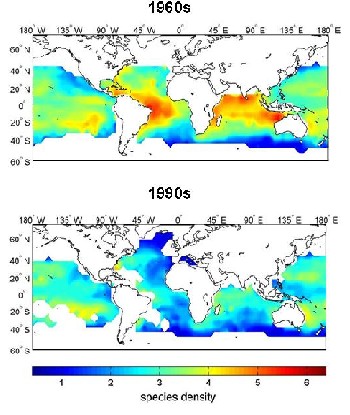
Declines in the number of species found on a standard longline in the 1960s and 1990s
|
First global map reveals rapidly shrinking hotspots for tuna, marlin, swordfish; Diversity has declined by up to 50% over 50 years due to fishing
A study released in Science reveals a striking downward trend in the diversity of fish in the open ocean - the largest and least known part of our planet. Teasing apart the effects of climate change and fishing over the past 50 years, the authors show a clear link to overfishing and highlight a surprising global pattern of open ocean hotspots - areas with predictable congregations of tuna, marlin, swordfish, and other ocean predators.
|
Go to the Press Material section of the FMAP website
Link to Editorial: "No Fish Story"
in The Washington Post, August 13, 2022
Links for the following: Jova Primary Care Pikel - website design company in Halifax Adapt Chiropractic
|
|
Fortune Magazine names Ransom Myers one of world's "Top Ten To Watch"Fortune, October 2005 |  | In October 2005, Ransom Myers was chosen by Fortune magazine as one of the world's top ten movers and shakers: people who will change the way the world operates over the next 75 years. The prominent business magazine predicted that Myers' work on fish population dynamics and the depletion of sharks, tuna and other fish species will foster "new and better ways to husband the wealth beneath the sea."
Fast Forward to the Future - Story on the Fortune magazine website
(scroll down to find Top Ten To Watch)
News Coverage
|
|
Direct and indirect fishery effects on small coastal elasmobranchs in the northern Gulf of MexicoTravis D. Shepherd and Ransom A. Myers
Ecology Letters, October 2005 |
|
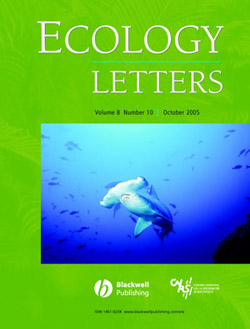 |
Sharks, rays and skates caught as bycatch by shrimp trawls and bottom longlines in the Gulf of Mexico have declined precipitously in the last 30 years (bonnethead 96%, Bancroft’s numbfish 98%, smooth butterfly ray > 99%). In fact, some species, such as the dusky shark, scalloped hammerhead, and great hammerhead, have not appeared in shrimp trawl surveys for the past 23 years, and may have been completely eradicated from the region. Co-incident with these declines, abundances of deeper water species like the Atlantic angel shark and the smooth dogfish have increased 6 to 13 times since 1972.
Since the diet of large coastal sharks consists of substantial amounts of smaller elasmobranchs, these prey populations are increasing, but only in deeper areas where they escape fisheries impacts. Such increases indicate the strong effect of predation by large coastal elasmobranchs, since their prey are increasing in spite of having low reproductive potential themselves (due to late age at maturity).
This paper demonstrates that shark species play a critical role in structuring coastal food webs in tropical and sub-tropical regions. The loss of these populations may have far-reaching impacts on ecological communities in these areas, effects that may be seen globally in tropical / subtropical regions with intense shrimp trawling and bottom longlining. |

|
|
New Understanding of Leatherback Turtle Behaviour and MigrationMichael C. James, Ransom A. Myers, and C. Andrea Ottensmeyer
Proceedings of the Royal Society, B, July 11th, 2005 (Available Online) |
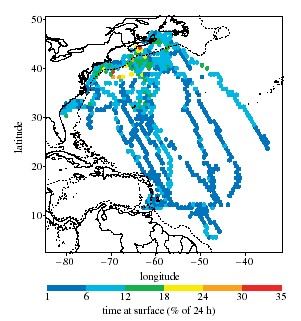
Time spent at surface by leatherback turtles
|
Leatherback turtles undergo extensive migrations from tropical to temperate waters. By tracking diving behaviour and horizontal movement and through direct observation, Mike James, Ransom Myers, and Andrea Ottensmeyer were able to identify different uses of coastal and pelagic areas by leatherbacks during their migration. For 25 male and female animals tagged off Nova Scotia, Canada, diving patterns observed in temperate waters were consistent with foraging. Foraging in temperate waters off Atlantic Canada and the northeastern United States may make animals vulnerable to incidental capture in these regions. |
|
Changing Open Ocean Communities in the Tropical Pacific Peter Ward and Ransom A. Myers
Ecology, April 2005 |  | In a paper published in the journal Ecology ("Shifts in open-ocean fish communities coinciding with the commencement of commercial fishing"), Ward and Myers compare open ocean fish abundances and biomass from recent years with those observed when industrial fishing began in the 1950s. The total biomass of pelagic fish caught on longlines was reduced by 90% between the 1950s and 1990s. This drastic reduction in the abundance of top predators by fishing could have dramatic consequences for the pelagic ecosystem, and Ward and Myers found preliminary evidence that such changes are occurring. They observed an increase in catches of small species such as the pelagic stingray and pomfrets which corresponded to declines in large predators. Ward and Myers suggest that this increase could be due to a reduction in predation pressure by large predatory fishes, resulting in increased abundance and/or geographical range for these smaller fish.
| The Pew Foundation Press Release, April 4, 2022
| |
|
Identification of high-use habitat and threats
to leatherback sea turtles in northern waters:
New directions for conservationM.C. James, C.A. Ottensmeyer and R.A. Myers
Ecology Letters, vol. 8 2005 |
| Incidental capture in fisheries threatens many marine vertebrates, however, conservation cannot be effective without identifying major sources of mortality. For the critically endangered leatherback turtle (Dermochelys coriacea), a reliance on fisheries observer data and an absence of behavioural datasets corresponding to a large and diverse sample of animals have focused conservation efforts on a very limited part of the species’ marine habitat. Using the largest satellite telemetry dataset for Atlantic leatherbacks, morphometrics from foraging animals, and entanglement records, we show annual return migrations to key feeding areas by males, females and juveniles, and demonstrate the importance of northern latitudes to leatherbacks. We show that leatherbacks are vulnerable to entanglement in northern coastal and shelf waters, where turtle-fishery interactions represent a greater threat to this species than previously recognized. Unless conservation efforts expand to coastal areas, present efforts alone will not be sufficient to save the species. |
| Article as pdf file |
|
Hatcheries and Endangered SalmonR.A. Myers, S.A. Levin, R. Lande, F.C. James, W.W. Murdoch, and R.T. Paine
Science, March 2004 | 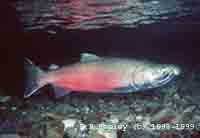 | Many of the wild salmon populations currently protected under the Endangered Species Act in the Northwest are in immediate danger of being delisted--not because they are recovering--but because their presence and status may block development. | | Paper | | Press release | Supplementary material | | 1) Hatcheries and Salmon | | 2) Related links | 3) Union of Concerned Scientists' website:
Deleting Scientific Advice on Endangered Salmon |
|
Shifting baselines and the decline of pelagic sharks in the Gulf of MexicoJulia Baum and Ransom A. Myers
Ecology Letters, February 2004 | 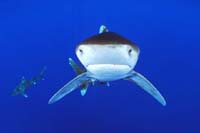 | Less than 1% of oceanic whitetip sharks - thought to have been the most common warm-water oceanic shark just fifty years ago - remain in the Gulf of Mexico today. "This tragedy is caused by continued overfishing and the demand for a single luxury item - sharkfin soup," says Dr. Ransom Myers, a world-leading fisheries biologist based at Dalhousie University in Halifax.
GO TO THE WEBSITE |
|
Predator diversity hotspots in the blue oceanBoris Worm, Heike Lotze, and Ransom A. Myers
PNAS, August 2003 | 
Article as pdf Science NOW article
Large oceanic predators concentrate in unique "diversity hotspots" much like those that exist on land, according to new research published this week in the prestigious U.S. journal "Proceedings of the National Academy of Sciences USA." Many predators, such as tunas, sharks, billfishes, and sea turtles, are of immediate conservation concern due to their vulnerability to overfishing, or high mortality as by-catch in commercial fisheries. Although terrestrial conservation efforts have focused on identifying and preserving such concentrations of vulnerable species, little is known about similar hotspots in the ocean. The scientists found that species diversity peaks at distinct locations, always located at intermediate latitudes (20-30 degrees North and South) where tropical and temperate species overlap. Hotspots are located close to prominent marine geographic features, such as reefs or shelf breaks. They are found east of Florida, south of Hawaii, and off the east coast of Australia, and within national waters. Additional studies show that these hotspot areas seem to be important for many species at once, from plankton to sharks. Through modeling, the researchers predicted that protecting these hotspot areas from fishing would yield greater benefits for threatened species than closing any other area. The scientists suggest that the ocean has unique, and previously unrecognized concentrations of pelagic species, which should be used to focus future conservation measures. They also propose that marine protected areas in national waters, combined with reduced fishing effort, could be used to safeguard threatened marine predators from further declines and ecological extinction. |
|
Rapid worldwide depletion of predatory fish communitiesRansom A. Myers and Boris Worm
Nature, May 15th, 2003 | 
Changes in the catch per unit effort in the Japanese longline fishery from 1952 to 2000, catch of tuna and billfish per 100 hooks.
Quicktime movie 23 MB Slide show | Analysis of data from five ocean basins reveals a dramatic decline in numbers of large predatory fish (tuna, blue marlins, swordfish and others) since the advent of industrialized fishing. The world's oceans have lost over 90% of large predatory fish, with potentially severe consequences for the ecosystem. These findings provide indirect support for goals established at the UN's World Summit on Sustainable Development in Johannesburg last year. UN officials argued that three-quarters of the world's fisheries were fished to their sustainable limits or beyond, and made proposals for the restoration of depleted fisheries by 2015. Data on predatory fish are important as they are not dependent on datasets from commercial fisheries, which can be unreliable.
GO TO THE WEBSITE |
|
Collapse and conservation of shark populations in the Northwest AtlanticJulia K. Baum, R.A. Myers, D.G. Kehler, B. Worm, S.J. Harley, and P.A. Doherty
Science, January 17, 2022 |  | Shark populations in the Northwest Atlantic have declined dramatically in the last two decades. Using an extensive dataset from the pelagic longline fishery, Baum and colleages have detected declines ranging from 40% for mako sharks to over 90% for hammerhead sharks. The magnitude of these changes suggests that several species are in danger of large-scale extirpation. The authors call for new marine reserves and a reduction in fishing effort to halt these trends. | Paper on Science website Science Now
This Week in Science |
|